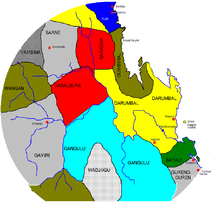Kangulu
The Kangulu, also written Gangulu, is an aboriginal tribe from the Mount Morgan area in Queensland, Australia.

Name
At least one variant name for the Kangulu, Kaangooloo was formed from the word for "no", i.e., ka:ngu.[1]
Language
The Kangulu language is considered to be a dialect of Biri, belonging to the Greater Maric languages.[2]
Country
Kangulu traditional lands occupied an estimated 6,000 square miles (16,000 km2) about the Dawson River as far south as Banana and Theodore. To the northwest, they extended as far as the Mackenzie River and the vicinity of Duaringa and Coomooboolaroo. Their eastern frontier lay towards Biloela, Mount Morgan, Gogango Range, and the upper Don River. Thangool and the headwaters of Grevillea Creek marked its southeastern limits.[1]
People
A correspondent of E. M. Curr's, Peter McIntosh, a resident of the area, stated that the Kangulu were a confederation of several tribes, the main ones being the Karranbal, the Maudalgo and the Mulkali.[3] No further data were recorded to enable Norman Tindale to clarify the precise nature of the last two groups.[1]
Along with many other remnants of Queensland tribes who had lost their traditional lands to colonial pastoralists, members of the Kangulu moved to the Cherbourg settlement.[4]
Alternative names
- Kaangooloo
- Cangoolootha (tha meant "speech")
- Khangalu, Kangalo, Kongulu, Kongalu
- Kangool-lo, Konguli, Gangulu[1]
Notes
Citations
- Tindale 1974, p. 174.
- Dixon 2002, p. xxxiii.
- McIntosh 1887, p. 58.
- Kelly 1935, p. 462.
Sources
- Dixon, Robert M. W. (2002). Australian Languages: Their Nature and Development. Volume 1. Cambridge University Press. ISBN 978-0-521-47378-1.CS1 maint: ref=harv (link)
- Howitt, Alfred William (1904). The native tribes of south-east Australia (PDF). Macmillan.CS1 maint: ref=harv (link)
- Kelly, C. Tennant (June 1935). "Tribes on Cherburg Settlement, Queensland". Oceania. 5 (4): 461–473. doi:10.1002/j.1834-4461.1935.tb00165.x. JSTOR 40327813.CS1 maint: ref=harv (link)
- Mathews, R. H. (1900). "The Toara Ceremony of the Dippil Tribes of Queensland". American Anthropologist. 2 (1): 139–144. doi:10.1525/aa.1900.2.1.02a00090. JSTOR 658865.CS1 maint: ref=harv (link)
- McIntosh, Peter (1887). "Eastern slopes of Expedition Range, Lower Dawson, Upper Fitzoy, MacKenzie and Isaacs rivers, and many of their tributaries." (PDF). In Curr, Edward Micklethwaite (ed.). The Australian race: its origin, languages, customs, place of landing in Australia and the routes by which it spread itself over the continent. Volume 3. Melbourne: J. Ferres. pp. 58–62.CS1 maint: ref=harv (link)
- Tindale, Norman Barnett (1974). "Kangulu (QLD)". Aboriginal Tribes of Australia: Their Terrain, Environmental Controls, Distribution, Limits, and Proper Names. Australian National University. ISBN 978-0-708-10741-6.CS1 maint: ref=harv (link)